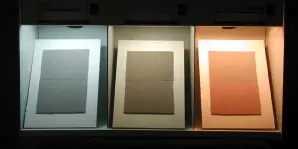
Visual examples of metamerism.
Understanding Metamerism in Color Matching
Why do the samples above look the same under one lighting condition but different under another? These samples exhibit metamerism, which means they match under some lighting conditions but not others. This can be a serious problem for manufacturers, especially those who combine various parts of different materials or sources into one product. Customers expect all parts of the products that they purchase to match in daylight as well as under the fluorescent lights of department stores or the tungsten light of their home.
As a result of this phenomenon, a Metamerism Index (MI) has been developed. The MI is a single number index that indicates how well two samples that match under one illuminant will match under another illuminant. The MI is calculated with the ΔL, Δa, and Δb values of a sample and a standard under a reference illuminant and a test illuminant. Usually the D65 illuminant (daylight) is used as the reference illuminant. For the MI to be meaningful and accurate the samples should be a good match under the reference illuminant.
HunterLab instruments and software have the ability to measure L a b values under a wide variety of illuminants and are well suited to measuring MI values. This allows HunterLab customers to evaluate their product under different lighting conditions to ensure that their product will meet their customer’s needs.

